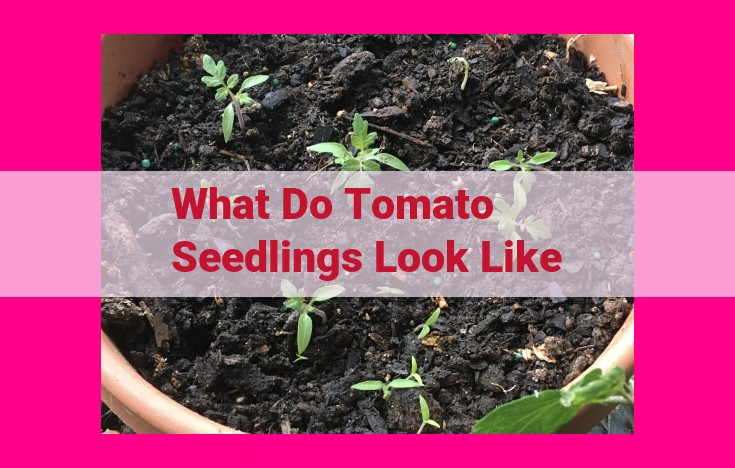Tomato Seedling Development: From Cotyledons To True Leaves

Tomato seedlings emerge with two rounded or oval cotyledons, which are initially green and smooth. They have a short hypocotyl, which connects the cotyledons to the root system. The epicotyl, the stem above the cotyledons, is initially short and slightly hairy. As the seedling grows, the epicotyl elongates and develops true leaves, which are indented and have a pointed shape.
Unveiling the Structure of Seedlings: Essential Components for Plant Life
Seedlings, the foundational building blocks of plant life, emerge from seeds, carrying within them the genetic blueprint for a thriving plant. They are a remarkable symphony of interconnected structures, each playing a pivotal role in the early development and survival of the plant.
Essential Entities of Seedling Structure
At the heart of a seedling lie the following essential components:
-
Cotyledons: These are the first leaves of the seedling, often appearing as two simple, seed-like structures. They serve as the initial source of nourishment for the plant, storing the food reserves necessary for growth. Cotyledons vary in shape, size, and color among different plant species.
-
Hypocotyl: This is the stem-like structure that connects the cotyledons to the root system. It helps support the seedling and allows for nutrient and water transport between the roots and the cotyledons. The hypocotyl is typically short and cylindrical.
-
Epicotyl: Located above the cotyledons, the epicotyl is the embryonic stem. Its function is to give rise to the true leaves and the above-ground structures of the plant. It is usually green and thin, with a visible growing point at its tip.
-
Root System: An extensive network of roots anchors the seedling in the soil and absorbs water and nutrients essential for growth. The root system consists of a primary root, which grows vertically downward, and lateral roots, which extend horizontally.
Seedling Morphology: Unveiling the Building Blocks of Plant Life
Cotyledons: The First Leaves of a New Life
Cotyledons are the first leaves that emerge from a germinating seed. They play a crucial role in providing nourishment to the young seedling before it has developed true leaves and an efficient root system. The shape, size, color, and texture of cotyledons vary greatly among species. Some seedlings, like beans, have thick, fleshy cotyledons that store food reserves. Others, like grasses, have small, thin cotyledons that serve primarily as protective sheaths.
Hypocotyl: The Bridge Between Root and Shoot
The hypocotyl is the stem-like structure that connects the root system to the cotyledons. It provides structural support and allows for the transport of water and nutrients from the roots to the developing shoot. The length, color, and texture of the hypocotyl can vary depending on the species. Some seedlings have a short, stout hypocotyl, while others have a slender, elongated one. The color can range from green to reddish, indicating the presence of chlorophyll or anthocyanins.
Epicotyl: The Heart of the Future Stem
The epicotyl is the part of the seedling that develops into the main stem. It emerges above the cotyledons and is characterized by its thin, upright appearance. The epicotyl contains undeveloped leaves that will later expand and form the first true leaves of the plant. Its color, texture, and position can provide clues about the growth habit and species of the seedling. Some seedlings have an erect epicotyl, while others have a curved or drooping one. The presence of hairs or trichomes on the epicotyl can also provide valuable identification traits.
Height and Growth Pattern of Seedlings
In the tapestry of plant life, seedlings emerge as tiny beacons of life, their delicate structures embarking on a remarkable journey towards maturity. Their height and growth pattern play a pivotal role in shaping their destiny and ensuring their survival in the competitive world of nature.
On average, seedlings exhibit a rapid growth rate, reaching impressive heights within a short span. This accelerated growth is essential for establishing a strong foundation and gaining a competitive advantage in the race for sunlight and nutrients.
The upright growth habit of seedlings is another defining characteristic. As they ascend skyward, seedlings stretch their tender stems towards the life-giving rays of the sun, seeking the nourishment that fuels their growth. This upright posture not only maximizes their access to sunlight but also provides structural support as they develop into sturdy plants.
The height and growth pattern of seedlings vary across species, reflecting their diverse adaptations to specific ecological niches. Some seedlings, such as sunflowers and corn, attain considerable heights, while others, like mosses and ferns, remain relatively diminutive. These differences stem from genetic factors and environmental cues, such as light availability and nutrient abundance.
As seedlings progress through their developmental stages, their height and growth pattern continue to evolve. Cotyledons, the first leaves to emerge, provide nourishment during the early stages of growth. As the seedling matures, true leaves take over the photosynthetic duties, and the cotyledons gradually wither away. The elongation of the hypocotyl and epicotyl contributes to the seedling’s increasing height, while the expansion of the root system anchors it firmly in the soil.
The journey of a seedling, from its humble beginnings to its transformation into a vibrant plant, is a testament to the resilience and adaptability of the natural world. The height and growth pattern of these tiny life forms hold profound significance, shaping their survival and ultimately contributing to the intricate tapestry of life on Earth.





